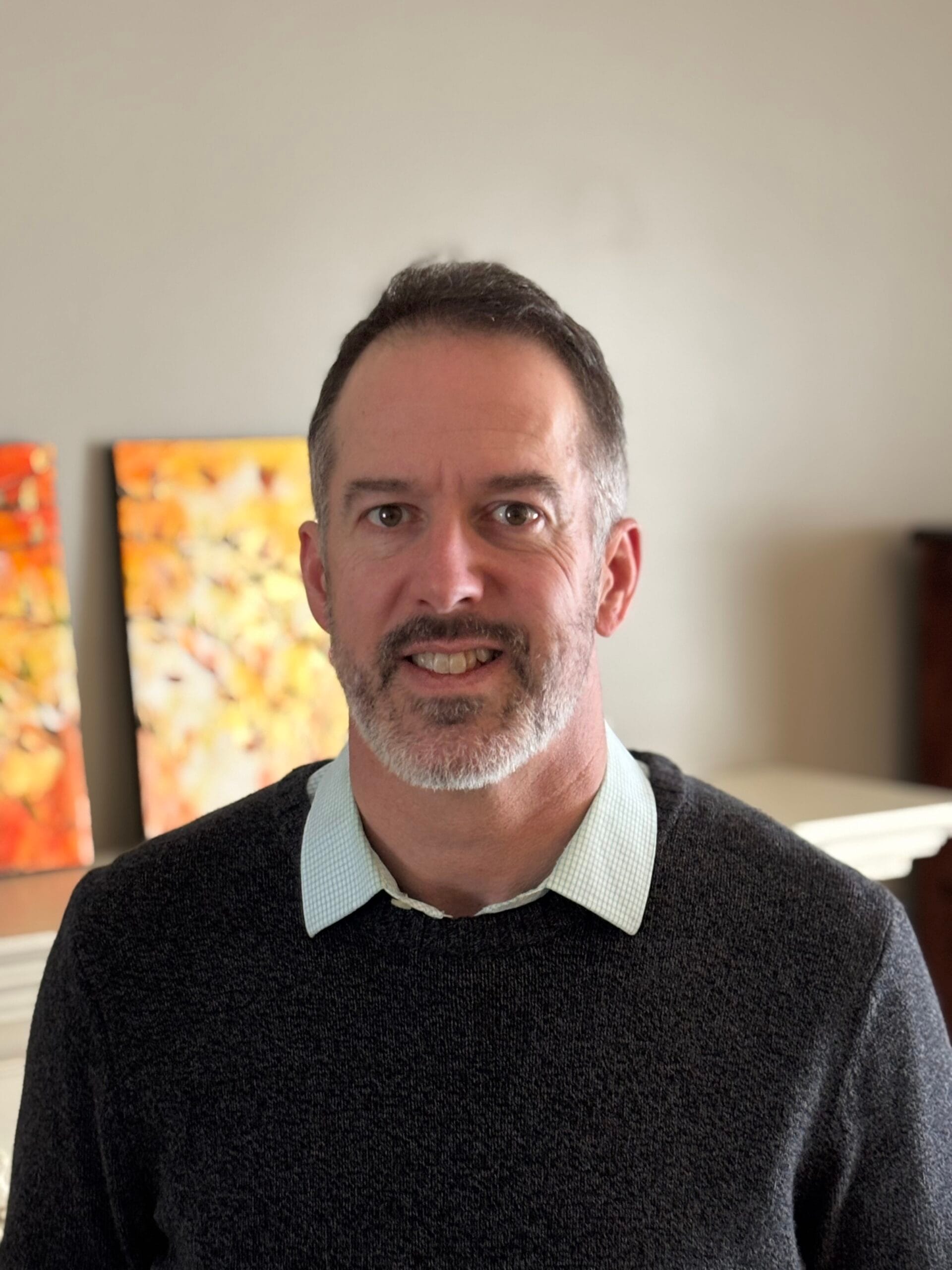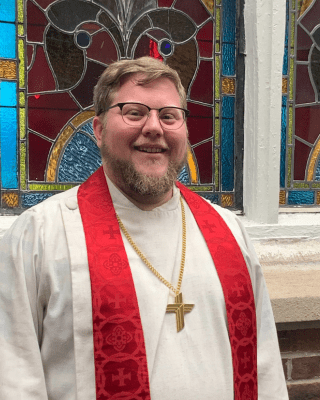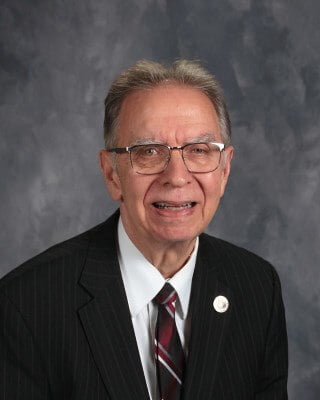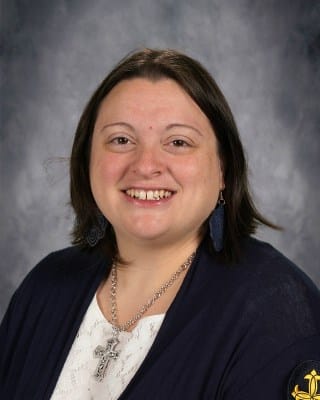About us
Trinity Lutheran Church is a member of the Lutheran Church-Missouri Synod (LCMS). We are a family of believers who support each other through worship and Christian life so that we may reflect the love of Jesus Christ and the grace of God to others.
Our Team


Vicar Tim Good
Operation Manager


Leadership
Congregational Leadership
Congregations of the Lutheran Church Missouri Synod are self-governing. This means that while we subscribe to and agree with the teachings of the national church body on matters of theology and doctrine, we are blessed with a governance structure through which all ministry business is handled and controlled by our local congregations.
Voters’ Assembly
At Trinity Lutheran Church, the Voters’ Assembly meets quarterly to discuss and vote on matters of the business of the ministry, including the election of officers, operating budget, and general church business.
Ministry and Administrative Boards
Board of Elders
The Trinity Lutheran Church Board of Elders provides oversight for the preaching and teaching of the pastors, assists in the administration of the Sacraments, reaches out to members who have become inactive, visits members who are unable to attend regular services, and ensures that all worship services are conducted in a proper worshipful atmosphere.
Trinity’s Elders are Steve Rossman – Head Elder, Brian Boehme, Adam Booher, Jim Croxton, Ted Haberman, Matt Hudacek, Mitch Hudson, Andrew Janetzke, Michael Kincaid, Brian Ogan, Dave Rohe, Byron Welt, Josh White, Josh Woody.
Our Vision Statement (What is our destination?)
We connect people to the Triune God. (Matthew 28:18-20; Romans 10:14)
Our Mission Statement (How will we get there?)
Empowered by the hearing and study of God’s word, the whole body at Trinity wisely and relentlessly stewards our resources to build awareness of our ministry, create connections in fellowship, nurture relationships with all we encounter, and make spiritually mature disciples of all congregants, until God’s work in our congregation bears fruit throughout our community.
Our Motto (What’s our mission in four words?)
Sharing Christ, Meeting Needs
Strategic Plan
Our 2023-2026 Strategic Plan focuses on strengthening connections at all stages of ministry, so that each person we encounter is so aware of Trinity’s ministry, so connected to its fellowship, so nurtured in loving relationships, and so well discipled that walking out the back door becomes unthinkable. To foster this mission, the plan will emphasize wise stewardship of organizational resources along with relentless love at all stages of ministry. Click here to access Trinity’s 2023-2026 Strategic Plan.
Trinity Lutheran Church Bylaws
Our Bylaws reflect a process of involvement by the members and staff toward projects and activities that will achieve our mission and vision, and provide Christian education for children from early childhood through twelfth grade. Click here to view the Trinity’s bylaws.
Our History
Throughout its rich history, members of Trinity have been tireless in their efforts to serve God’s people and spread the message of salvation through His Son, Jesus Christ. Early members of Trinity Lutheran Church were instrumental in opening elementary schools in the area, as well as a local college, seminary, and hospital. Today, the members of Trinity Lutheran Church continue their efforts in Sharing Christ and Meeting Needs through an array of mission and outreach projects. Believing that God has placed us in our location for a distinct purpose, the congregation remains committed to downtown Springfield.
1839 — Rev. Francis Springer arrives in Springfield. He is a graduate of Gettysburg Lutheran Seminary in Pennsylvania. He supports his family by opening a private school.
1841 — The first Lutheran worship service in Springfield is held in Rev. Springer’s home. Rev. Daniel Scherer, the “Father of Illinois Lutheranism“, assists in the service. Abraham Lincoln would later purchase a home across the street from Rev. Springer’s house.
1844 — German Lutherans of Springfield are invited to join Springer’s congregation.
1846 — Concordia Theological Seminary is founded in Fort Wayne, Indiana.
1847 — Rev. Springer leaves Springfield to form a theological seminary in Hillsboro. Its full name was Literary and Theological Institute of the Evangelical Lutheran Church of the Far West, but it was commonly referred to as Hillsboro College.
1847 — The Beginning of the Missouri Synod – On Sunday, April 25, Die Deutsche Evangelish-Lutherische Synode von Missouri, Ohio und Anderen Staaten (The German Evangelical Lutheran Synod of Missouri, Ohio and Other States) was formed in St. Paul’s Church in Chicago. C.F.W. Walther was elected first president. Der Lutheraner was formally made the official publication of the new synod.
1851 — Springfield Lutherans purchase the former Presbyterian Church which had been erected in 1830. Said to be the first brick church in Illinois, it was on 3rd Street, midway between Washington and Adams.
1852 — Hillsboro College moves to Springfield under Rev. Springer and Rev. Simon Harkey’s leadership. It is renamed Illinois State University.
1854 — Illinois State University dedicates an impressive school building on Springfield’s north-east side.
1854 — Springfield Lutherans divide amicably along linguistic lines: the English speaking would become Grace Lutheran Church and the German speaking (Deutsche Evangelische Lutherische Kirche) would become Trinity.
1860 — Springfield German Lutherans adopt the name Trinity for their congregation.
1860 — Trinity begins a day school in February of this year. It is believed that classes were held over a grocery store in downtown Springfield. This is the beginning of Trinity Lutheran School.
1860 — Trinity razes its Third Street church building and erects a three steepled church on the same site.
1863 — Trinity calls its first Missouri Synod pastor, Rev. William Bartling.
1865 — Trinity’s Adult Choir is formed.
1865 — Trinity purchases a home and remodels it to be used as a school. It is located on the north side of Jefferson between First and Second Streets.
1867 — The Lutheran institution, Illinois State University, closes its doors.
1872 — Trinity joins the Missouri Synod.
1875 — Concordia Theological Seminary moves from St. Louis to Springfield under the leadership of Rev. Craemer. They utilize the former Illinois State University building which is soon nicknamed “die Kaffeemuehle” because of its similarity to a coffee mill.
1880 — Trinity razes its school building (a former home) and builds a new school on the site. It is at 123 West Jefferson.
1880 — Trinity’s Ladies Aid (Tabea Verein) is formed.
1889 — Trinity dedicates its present church at 2nd and Monroe. Over 5,000 people attend the ceremonies.
1891 — Luther Hall is dedicated at Concordia Theological Seminary.
1895 — Trinity establishes a branch elementary school on the Seminary Grounds.
1897 — Trinity Pastor Martin Luecke leads efforts to found the Springfield Hospital and Training School, now Memorial Medical Center. Trinity’s lay people and Concordia’s professors are instrumental in the organization and running of the hospital.
1905 — Electric Lighting replace gas lights in the church. (Note: During the recent renovation some of the old gas pipes were exposed.)
1906 — Trinity builds a modern school behind the church at Second and Monroe.
1916 — Trinity builds a modern school on the north-east side of Springfield for the many children of people employed in the coal mines, Pillsbury Mills, the Illinois Watch Factory, the railroad yards, and other businesses. The school is named Immanuel.
1920 — Trinity Church building is renovated.
1923 — First “Moving Pictures” were shown in Trinity School.
1924 — Trinity’s Youth join the International Walther League.
1926 — Trinity releases about 200 members to form Immanuel Church and the Immanuel School building is presented to the new congregation.
1926 — The Walther League installs the first phone in Trinity, it was located in the kitchen.
1927 — The corporate name for Trinity is changed from German to English.
1930 — A branch Sunday School is started in West Grand School (on Wabash Avenue).
1934 — The “Kaffeemuehle” on the seminary grounds is razed.
1936 — The largest renovation Trinity Church has undergone begins. It is a five year effort.
1939 — The Schocknecht Organ is dedicated replacing the old Pilcher Organ.
1940 — Trinity begins offering deaf-mute services.
1946 — Trinity employs its first secretary.
1947 — Boy Scouts begins at Trinity.
1951 — Luther Statue on Seminary grounds is dedicated.
1953 — Girl Scouts begins at Trinity.
1953 — The last regular German Service is held at Trinity on June 18, 1953 with 18 people in attendance.
1953 — The annual cost to the congregation for each student at Trinity is reported to be $91.23.
1954 — Our present school building at 515 S. MacArthur Blvd is dedicated on August 29. 1954.
1954 — First Newsletter is published.
1960 — A segment of Trinity members are released to form the west side congregation of Our Savior’s.
1964 — The school building located at Second and Monroe Street is demolished.
1972 — Extensive renovations take place at the church, and a new Cassavant organ is installed.
1976 — After 99 years in Springfield, Concordia Seminary moves to Fort Wayne, Indiana. The buildings and grounds are presently used by the State of Illinois Department of Corrections for training of employees.
1997 — Extensive renovations to both church and school buildings are completed.
1997 — Trinity embarks on a Master Plan formulation for the future of its Springfield Mission.
2001 — Trinity dedicates an addition to the school at 515 S. McArthur Blvd. featuring a Learning Center for children, a large Parish Hall, school and pastoral offices, a kitchen adjacent to the Parish Hall, a modern science room, a music room, a computer classroom, an elevator making the building handicap accessible, a congregational library/meeting room, an archival storage room and a large paved and lighted parking area.
2016 — Trinity celebrates its 175th anniversary in October. As part of this milestone anniversary, Trinity adopts a three-year, $3 million capital campaign for renovations to the church ($1.8 million) and school ($1.2 million
2017 — Major renovations begin at both the church and school campuses. Work at the church campus includes the construction of a 2,000 sq. ft. addition (with handicapped accessibility, first-floor office space, restrooms, and nursery), tuck-pointing exterior brickwork; updated lighting system, and more. School renovations include tuck-pointing, new flooring, heating system upgrade and new bathroom fixtures.
2018 — A ribbon-cutting ceremony is held on June 18, 2018 at the church campus with Trinity leadership, members of Trinity, and members of Chamber of Commerce Ambassadors in attendance.
2018 — Trinity congregation resumes worshipping at the 2nd & Monroe Street campus on June 24, 2018 with a special Dedication Service.
